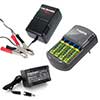Choosing well its bike to electric assist (VAE) battery
Published on 04/21/2014

The principle of the electric bike is to provide assistance with the pedal to the user. The battery of the EAB sends its energy to the engine to amplify the movement of the pedal.

Different types of batteries:
The battery is characterized by its voltage in Volts (V) and its capacity in amp hour (Ah). On a battery of VAE, the voltage (V) responds to an impression of power and capacity (Ah) corresponds to autonomy.
By comparison, the battery voltage is equivalent number of horses of a car and capacity corresponds to the volume of the tank.
| Benefits | Disadvantages |
LEAD |
|
|
NICD / NIMH |
|
|
LITHIUM |
|
|
Precautions to be taken to prolong the battery life:
- Use a suitable charger, at the risk of damaging your battery
- In the event of prolonged immobilization, load it before it is stored
- After a refill, if si possible can wait an hour before using your bike
- After use, leave the battery at least an hour before recharging
- Store your battery in a dry place with a temperature between 10 ° c and 20 ° C away from a direct heat source
Estimated battery life:
- Lead: 300-400 cycles *; either 3/4 yrs
- NICD/NIMH: 500 cycles *; either 4/5ans
- Lithium: 600 to 1300 cycles *; 6/10 years
* A cycle corresponds to a load and discharge the battery.
Estimate of your battery:
Autonomy depends on several factors:
- The type of road and weather conditions
- The corpulence of the user and its loading
- The effort by the user
- Type of tyres
- The battery (capacity, wear it)
- Engine power
To quickly calculate your battery (for a user to Middleweight and in normal weather conditions), do the following calculation: *.
Autonomy = capacity (ampere-hours) x voltage (Volts) / power (Watts)
Example: for a battery 36 Volt 10Ah and a 200-watt motor. This gives:
36 X 10 = 360
360/200 = 1 hour and 48 minutes at full power.
* These values are as purely indicative. These can be doubled if you pedal often or divided by two if you do not ride.
- Posted on
- Stories
Post related products
-

Lead Yuasa battery 12V 12Ah NP12-12 NP12-12
-

Battery Velo 36V PowerPack 400 Li-Ion BOSCH Ebike Blanche 0275007504
-

Battery Int. for bike Yamaha PX24C, PX26C 24V 9Ah REC-VELO24/9
-

24V 4.5Ah Bike Battery Kit for NKY178B02 NKY178B02
-

Battery Bike 36V 10Ah LiFeP04 SilverFish - Charger LIT/01.02.0002
-

Battery bike 24V 10Ah Li-ion FROG + charger LIT/01.01.0003
-

Replacement 24V 4.5Ah for bike Yamaha PAS battery RECVELO24/5
-

Giant Twist Energy Set 24V 9Ah NiMh Bike Battery Kit Rec-Twist-Energie
-

Bike battery Carry Luggage PowerPack 400 Li-ion compatible BOSCH 36V GD-BOS-E36B
-

Battery bicycle 36V PowerPack 400 PERFORMANCE BOSCH 0275007512
-

Charger BOSCH for ACTIVE battery and PERFORMANCE 36V Powerpack 0275007909
-

Bosch Charger battery bicycle 36V PowerPack400 0275007905-2
-

Battery int. 24V 5Ah VAE NATIONAL panasonic NKY121B01 RECVELO24/5
Battery reconditioning for EasyLand EasyBike 24V 9.5Ah e-bikes EASYLAND24
-

Battery bike door luggage 36V Li-ion Rear Rack + charger LIT/01.01.0001
-

Bicycle 36V Li-ion battery charger Lit/04.01.0013
-

Replacement for bike Matra I-Step 24V 9Ah battery RECVELO24/9
-

Battery reconditioning for Electric Bike 36V 9Ah NiMh Rec-36-9H
-

Battery 36V 13Ah Li-Ion type Panasonic for Electric Bike Kalkhoff, Ralei... GD-PAN-E36B
-

Battery bike door luggage 36V PowerPack 500 Performance BOSCH 0275007532
-

Battery bike BOSCH PowerTube 500 vertical 36V 500 Wh 0275007540
Express delivery
- By carrier or
- By Postal Service
Professional Quality
Secured Payment
Search in Blog
Par Stephane C. (Viviers du lac, France métropolitaine) le 17 Apr. 2025 :
Par Jacques C. (L' ISLE SUR LA SORGUE, France métropolitaine) le 15 Apr. 2025 :
Par Philippe M. (Tinteniac, France métropolitaine) le 14 Apr. 2025 :
















COMMENTS
No customer comments for the moment.